2006 Egypt
29 December 2006, Friday; Marsam Hotel,
Luxor, LE110
Another super day.
Which we began with a balloon ride! (Our
hostess, Natasha, had arranged this for us having priced the various options
and gotten us an excellent deal at LE350 each – under R1,000 and much cheaper
than we anticipated.) We were collected at the hotel at 06h50 by the owner of
Sindbad – who showed us photos of his two daughters – 8 months and 2 years –
one on each of his two cell phones. Both of which he kissed.
His balloons were already in the air with
his first lot of passengers. And we had to chase them around in the changing
wind until they finally landed in a field. Then out of the van – and others out
of theirs – to run across the field with the young men tasked with holding down
the still-inflated balloon while those within scrambled out over the high sides
of the basket and those without scrambled in. Two men had grabbed me by my
elbows intending to lift me over the chest-high basket sides. Ludicrous. I told
them they would not be able to lift me and climbed in myself with relative ease
and considerably more dignity.
After a quick safety chat – exclusively
about what to do when landing – we were off. A gentle take-off and a magical
time drifting above the fields and temples of West Bank Luxor. The most
striking thing about seeing this part of the world from the air, is seeing the
line between the irrigated Nile valley and the desert. We had read about this
line, but seeing it in reality is striking. From green to tan in one clean
sweep. No fade-out; no trees or bushes dotted in the sand. Just absolute green
to absolute nothing.
Unfortunately we did not catch winds to
take us over the Valley of the Kings. And only saw Hatshepsut’s Temple from a
distance. But saw it clear and magnificent against its cliff. Also the
Ramesseum and Medinat Habu – neither of which we plan to visit.
And wonderful views of the fields and homes
and lives of the people here. Poor, but not destitute. Corn and dung and dates
drying on the flat rooftops. Small courtyards with giant cabbages and the odd
donkey. Purple plastic chairs on tiny balconies. Fields of bananas and sugar
cane. With the Nile incandescent in the morning sun. And our balloon blue above
us.
On board were a young British couple and
their young daughter. He lectures at Cairo Uni and the little one was born in
Egypt. The young woman told us about flying into Cairo on Egypt Air and having
the pilot broadcast that I’nsh Allah (God willing) they would be landing in 15
minutes. This saying is utilised all the time – to the discomfort of westerners
who would rather less was left in the hands of god.
And just a gentle, peaceful pace through a
Friday sky. We tried twice unsuccessfully to descend and finally came down
gently and professionally in the desert itself.

Balloon ride
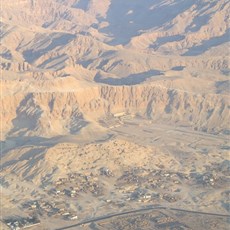
Balloon ride
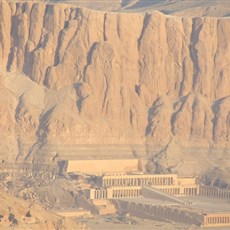
Balloon ride
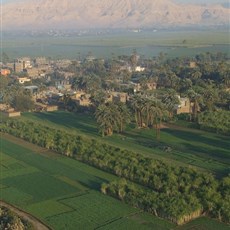
Balloon ride
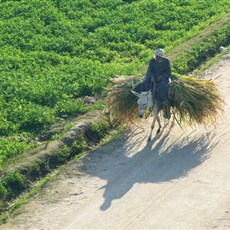
Balloon ride
And so home for breakfast before mounting our bikes and cycling out to Deir el-Bahri (Hatshepsut’s Temple). The parking area here was choc-a-bloc with tour buses. But neither they nor the camera-clicking crowds of tourists detracted from the temple in its natural amphitheatre of cliffs – all red and brown against a blue, blue sky.
Hatshepsut was the daughter of Tuthmosis I. She married her half-brother Tuthmosis II. His son, Tuthmosis III, by a minor wife, was to be his successor. When Tuthmosis II died, Tuthmosis III was still young and Hatshepsut became co-regent and then pharaoh. She ruled for 20 years during a time of peace and internal growth. She died (disappeared?) in 1458BC.
Aside: Women in ancient Egypt had considerably more power than was elsewhere the norm then or for a long time thereafter (and more than many women have today). They could own land, inherit from family members, and go to court to defend their rights. They received equal pay for equal work. Royal queens often ruled alongside the Pharaoh who had to govern by the rules of the goddess Maat, goddess of truth and symbol of cosmic order. The goddess Isis was regarded as “More powerful than 1,000 soldiers”. Women rulers include: Neithikret (2148-2144BC), Sobekneferu (1799-1795BC), Hatshepsut (1473-1458BC), Nefertiti (who initially ruled alongside her husband Akhenaten) (1338-1336BC) and Cleopatra (51-30BC).
Her stunning temple was known as the “Sublime of the Sublimes”. Hatshepsut’s architect was apparently her lover. Either way, he did her proud. Her temple, all pillars and majesty, melds into the majestic surroundings. It took 15 years to build against and mimicking towering limestone cliffs in an amphitheatre dedicated for over 500 years to Hathor. It is partly rock-cut, partly free-standing.
We used our Valley of the Kings guide book and took particular note of the following: the engraved and painted story of the transportation of Hatshepsut’s two obelisks from Aswan to Karnak Temple. Other stories on the walls depicting her coronation and her relationship with Hathor. The Chapel of Hathor (cow-headed goddess of the sky, love, music, and dancing) with its Hathor-headed columns and its scenes showing a procession of the Pharaoh’s soldiers and boats and Hathor as a cow licking the Pharaoh’s hand, amongst many others. Her soldiers celebrating their return from the Punt (Ethiopian) expedition to collect myrrh trees needed for incense in temple ceremonies. The god Amun (sun god; king of the gods) before a table of offerings. The goddess Nekhbet (patron goddess of Upper Egypt and of childbirth) in the form of a vulture with protective wings.
We spent a couple of hours inspecting graphics and hieroglyphs and columns and statues and views. Lovely.

Hatshepsut's temple

Hatshepsut's temple
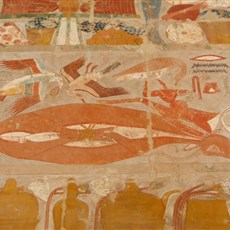
Hatshepsut's temple
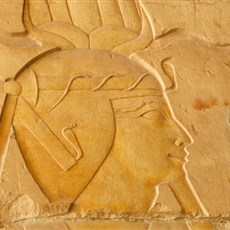
Hatshepsut's temple
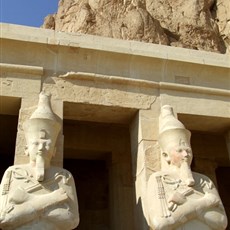
Hatshepsut's temple
After an expensive “lunch” – crisps and cokes at the temple café (over which Charl has not yet ceased to complain, especially as we did in fact cycle later past a better real lunch option), we cycled on to the King’s Valley. A gentle incline over several kms into the desolate silent hills. Just us and the squeaking of our bikes in a vast silence – broken now and then by a taxi or bus.
OK, the ancient Egyptians were quite mad. It’s official. Obsessed with life in the hereafter. Their tombs are fascinating and magnificent – but if all that ability and energy and tax money had been directed elsewhere, Egypt today may have been a leading light in the world.
Instead we visit the graves of madmen.
We visited three tombs for our LE140:
Ramses I 1295-1294BC (KV16)
Ramses III 1186-1154BC (KV11)
Thutmose III 1479-1425BC (KV34)
Unfortunately, two that we had planned to see were closed, but we were happy in the end with our selection.
The first tomb was small – the pharaoh’s reign being short. And simple. Just one passage down to a small room containing his sarcophagus. Stunning paintings and colours.
The second was considerably bigger and more elaborate. With detailed hieroglyphs for long stretches and beautifully-rendered images of the pharaoh and the gods.
The third we visited primarily for its complex entry – a long climb up and down. Designed to prevent it being found and robbed, but unsuccessfully so.
We had a super (and easy) ride back, turned in our bikes, slept for an hour and dined at the Marsam on barbecued steak.
The Marsam is a super hotel with a mix of long- and short-stay guests most of whom dine at the hotel in the evenings. And so one ends up meeting and chatting to a variety of people. An elderly British teacher fascinated with the Arab world and the desert since his youth – who took great pleasure in his Gordoon’s Gin (the bottle looked the same, but was obviously not the original Gordon’s). A toothy blonde Brit photographing and trying to prevent the destruction of the mudbrick homes near the West Bank tombs. A Frenchman and his family visiting Egypt with their Coptic son-in-law-to-be – who was educated in France and is “cultured and subtle”. The hotel also doubles as an art gallery with displays by local artists.
Great day!
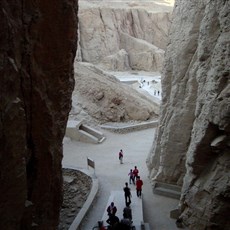
Valley of the Kings
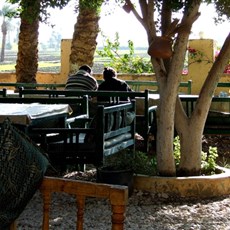
Marsam Hotel